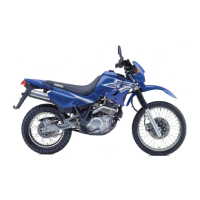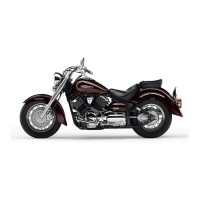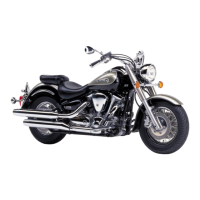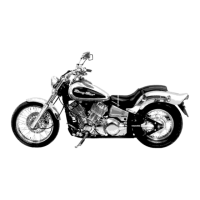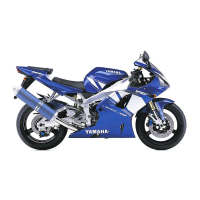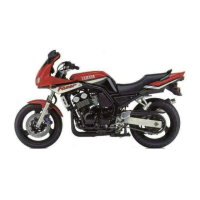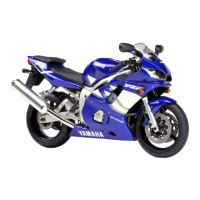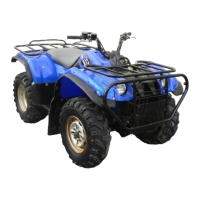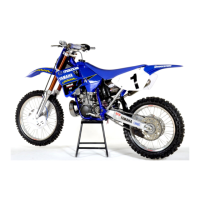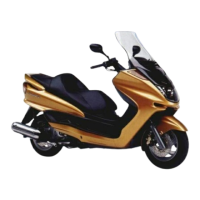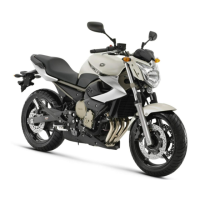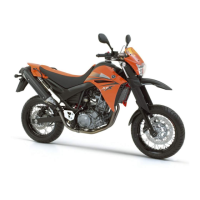Do you have a question about the Yamaha XN125 2000 and is the answer not in the manual?
Identifies the scooter's VIN and model label for parts ordering.
Describes key features like the oil indicator light, odometer/tripmeter modes, clock, and auto-choke system.
Provides crucial guidelines for removal, disassembly, and safe handling of parts and materials.
Details procedures for inspecting electrical leads, couplers, and connectors for stains or corrosion.
Lists necessary special tools with part numbers and illustrations for tune-up and assembly.
Lists key dimensions, weights, engine details, oil/coolant capacities, and fuel tank capacity.
Details standard and limit values for engine, chassis, and electrical components for servicing.
Provides metric to imperial unit conversion factors for various measurements like torque, weight, and volume.
Specifies general tightening torques for standard fasteners based on thread pitch and size.
Lists specific engine and chassis tightening torques for various bolts and nuts.
Identifies lubrication points and corresponding lubricant symbols for engine and chassis components.
Illustrates the routing and components of the scooter's cooling system with numbered parts.
Shows oil flow paths within the engine for lubricating critical components like the cylinder and crankshaft.
Illustrates the correct routing of electrical wires, cables, and hoses for proper assembly and function.
Outlines the recommended maintenance schedule based on odometer readings and annual checks.
Details procedures for removing and installing side covers, seat, front cover, and inner panels.
Covers recommended adjustments and checks for valve clearance, idling speed, and spark plug condition.
Details checks and adjustments for front/rear brakes, steering head, tires, wheels, and suspension.
Covers checks for battery condition, fuses, bulb replacement, and basic electrical system troubleshooting.
Covers engine-related wiring, cables, hoses, air filter, and mounting bolts removal and installation.
Details removal, checking, and installation procedures for the camshaft, rocker arms, and timing components.
Covers removal, checking for warpage, and installation of the cylinder head assembly.
Details removal, checking, and installation procedures for valves, springs, seats, and guides.
Covers removal, checking, and installation of the cylinder, piston, piston rings, and piston pin.
Details removal, disassembly, checking, and assembly of the clutch, V-belt, and sheave components.
Covers removal, checking, and installation of starter clutch, generator, magneto cover, and stator coil.
Details removal and checking procedures for the engine's oil pump components like gears and housing.
Covers disassembly, checking, and assembly of the crankcase halves and crankshaft assembly.
Details removal and installation of transmission components including gears, axles, and covers.
Covers removal, checking for damage, and installation of the radiator and its associated hoses and fan.
Details checking the thermostat's operation by temperature and its installation procedure.
Covers removal, checking for damage, and installation procedures for the water pump assembly.
Details removal, disassembly, checking of components, and assembly of the carburetor.
Covers removal, checking, and installation of the front wheel, brake disc, caliper, and axle.
Details checking and adjustment of the rear wheel, brake shoes, drum, and camshaft.
Covers replacement of brake pads, master cylinder service, and caliper disassembly and checking.
Details disassembly, checking, and assembly of the front fork legs, including oil replacement.
Covers checking and installation procedures for the handlebar, grips, levers, and switches.
Details removal, checking, and installation procedures for the steering head bearings and components.
Covers removal and checking procedures for the rear shock absorber assembly and exhaust pipe.
Provides an overview and illustration of the scooter's electrical components and their connections.
Details checking switch continuity using a pocket tester and identifying switch positions and wire colors.
Explains how to check bulb types, condition, socket continuity, and recommended replacement schedule.
Provides a circuit diagram and troubleshooting guide for the ignition system, including spark plug and coil checks.
Includes a circuit diagram and troubleshooting steps for the starter motor, relay, and battery system.
Details removal, disassembly, checking of components, and assembly of the starter motor.
Provides a circuit diagram and troubleshooting for charging system issues like battery not charging or stator coil resistance.
Includes circuit diagrams and troubleshooting for headlights, signals, brake lights, meter lights, and related switches.
Provides circuit diagrams and troubleshooting for turn signals, brake lights, horn, and indicator lights.
Includes circuit diagrams and troubleshooting for the radiator fan motor, thermo switch, and temperature warning light.
Provides a circuit diagram and troubleshooting for the carburetor heating system, including thermo switch and heater element.
Lists common causes for engine starting failures, categorized by system (engine, fuel, electrical).
Identifies engine, fuel system, carburetor, and electrical causes for incorrect idling speed.
Details potential issues in engine, fuel system, and carburetor affecting performance at higher speeds.
Lists common causes for clutch malfunction, including V-belt, pulley, spring, and gear issues.
Identifies engine, cooling system, fuel system, chassis, and electrical causes of engine overheating.
Lists cooling system causes for engine overcooling, primarily related to thermostat operation.
Details common causes for poor braking performance in both disc and drum brake systems.
Lists causes for front fork leg malfunction, including oil leaks, bent components, and incorrect oil levels.
Lists general malfunctions related to front fork legs such as bent parts, damaged springs, or incorrect oil viscosity.
Covers issues related to handlebar, steering head, front forks, swingarm, tires, wheels, and frame affecting stability.
Lists common problems with headlights, turn signals, brake lights, horn, and other signaling system components.
Identifies the scooter's VIN and model label for parts ordering.
Describes key features like the oil indicator light, odometer/tripmeter modes, clock, and auto-choke system.
Provides crucial guidelines for removal, disassembly, and safe handling of parts and materials.
Details procedures for inspecting electrical leads, couplers, and connectors for stains or corrosion.
Lists necessary special tools with part numbers and illustrations for tune-up and assembly.
Lists key dimensions, weights, engine details, oil/coolant capacities, and fuel tank capacity.
Details standard and limit values for engine, chassis, and electrical components for servicing.
Provides metric to imperial unit conversion factors for various measurements like torque, weight, and volume.
Specifies general tightening torques for standard fasteners based on thread pitch and size.
Lists specific engine and chassis tightening torques for various bolts and nuts.
Identifies lubrication points and corresponding lubricant symbols for engine and chassis components.
Illustrates the routing and components of the scooter's cooling system with numbered parts.
Shows oil flow paths within the engine for lubricating critical components like the cylinder and crankshaft.
Illustrates the correct routing of electrical wires, cables, and hoses for proper assembly and function.
Outlines the recommended maintenance schedule based on odometer readings and annual checks.
Details procedures for removing and installing side covers, seat, front cover, and inner panels.
Covers recommended adjustments and checks for valve clearance, idling speed, and spark plug condition.
Details checks and adjustments for front/rear brakes, steering head, tires, wheels, and suspension.
Covers checks for battery condition, fuses, bulb replacement, and basic electrical system troubleshooting.
Covers engine-related wiring, cables, hoses, air filter, and mounting bolts removal and installation.
Details removal, checking, and installation procedures for the camshaft, rocker arms, and timing components.
Covers removal, checking for warpage, and installation of the cylinder head assembly.
Details removal, checking, and installation procedures for valves, springs, seats, and guides.
Covers removal, checking, and installation of the cylinder, piston, piston rings, and piston pin.
Details removal, disassembly, checking, and assembly of the clutch, V-belt, and sheave components.
Covers removal, checking, and installation of starter clutch, generator, magneto cover, and stator coil.
Details removal and checking procedures for the engine's oil pump components like gears and housing.
Covers disassembly, checking, and assembly of the crankcase halves and crankshaft assembly.
Details removal and installation of transmission components including gears, axles, and covers.
Covers removal, checking for damage, and installation of the radiator and its associated hoses and fan.
Details checking the thermostat's operation by temperature and its installation procedure.
Covers removal, checking for damage, and installation procedures for the water pump assembly.
Details removal, disassembly, checking of components, and assembly of the carburetor.
Covers removal, checking, and installation of the front wheel, brake disc, caliper, and axle.
Details checking and adjustment of the rear wheel, brake shoes, drum, and camshaft.
Covers replacement of brake pads, master cylinder service, and caliper disassembly and checking.
Details disassembly, checking, and assembly of the front fork legs, including oil replacement.
Covers checking and installation procedures for the handlebar, grips, levers, and switches.
Details removal, checking, and installation procedures for the steering head bearings and components.
Covers removal and checking procedures for the rear shock absorber assembly and exhaust pipe.
Provides an overview and illustration of the scooter's electrical components and their connections.
Details checking switch continuity using a pocket tester and identifying switch positions and wire colors.
Explains how to check bulb types, condition, socket continuity, and recommended replacement schedule.
Provides a circuit diagram and troubleshooting guide for the ignition system, including spark plug and coil checks.
Includes a circuit diagram and troubleshooting steps for the starter motor, relay, and battery system.
Details removal, disassembly, checking of components, and assembly of the starter motor.
Provides a circuit diagram and troubleshooting for charging system issues like battery not charging or stator coil resistance.
Includes circuit diagrams and troubleshooting for headlights, signals, brake lights, meter lights, and related switches.
Provides circuit diagrams and troubleshooting for turn signals, brake lights, horn, and indicator lights.
Includes circuit diagrams and troubleshooting for the radiator fan motor, thermo switch, and temperature warning light.
Provides a circuit diagram and troubleshooting for the carburetor heating system, including thermo switch and heater element.
Lists common causes for engine starting failures, categorized by system (engine, fuel, electrical).
Identifies engine, fuel system, carburetor, and electrical causes for incorrect idling speed.
Details potential issues in engine, fuel system, and carburetor affecting performance at higher speeds.
Lists common causes for clutch malfunction, including V-belt, pulley, spring, and gear issues.
Identifies engine, cooling system, fuel system, chassis, and electrical causes of engine overheating.
Lists cooling system causes for engine overcooling, primarily related to thermostat operation.
Details common causes for poor braking performance in both disc and drum brake systems.
Lists causes for front fork leg malfunction, including oil leaks, bent components, and incorrect oil levels.
Lists general malfunctions related to front fork legs such as bent parts, damaged springs, or incorrect oil viscosity.
Covers issues related to handlebar, steering head, front forks, swingarm, tires, wheels, and frame affecting stability.
Lists common problems with headlights, turn signals, brake lights, horn, and other signaling system components.
| Brand | Yamaha |
|---|---|
| Model | XN125 2000 |
| Category | Motorcycle |
| Language | English |
